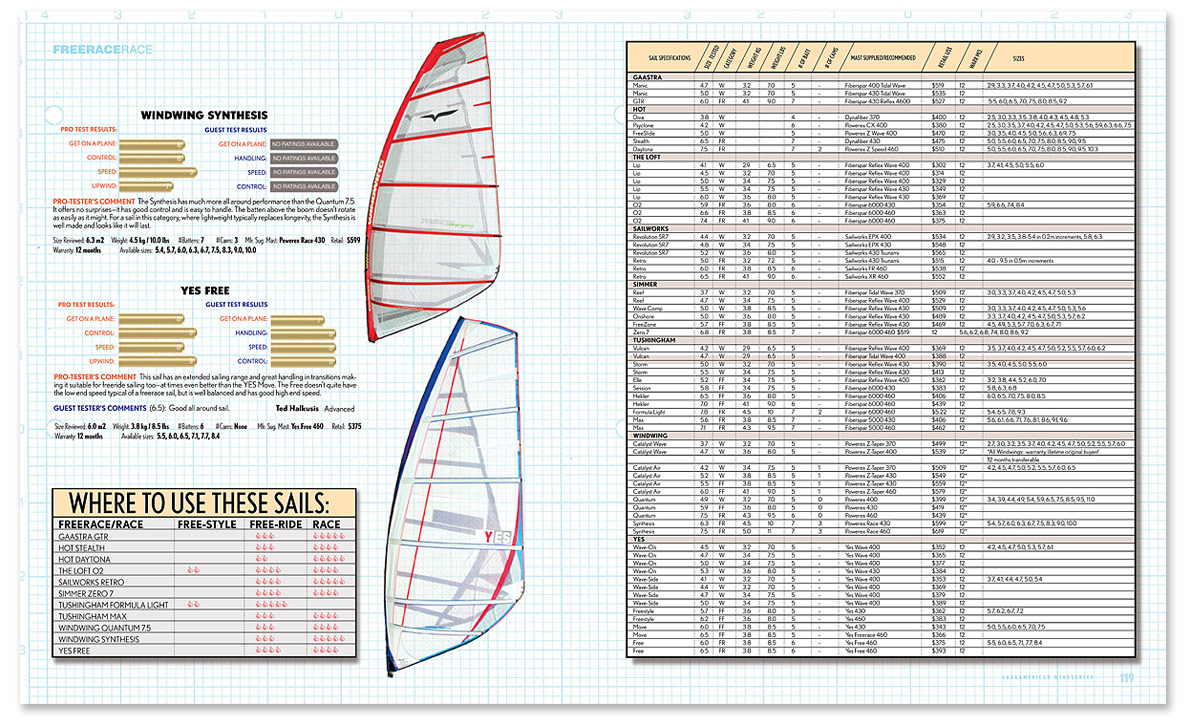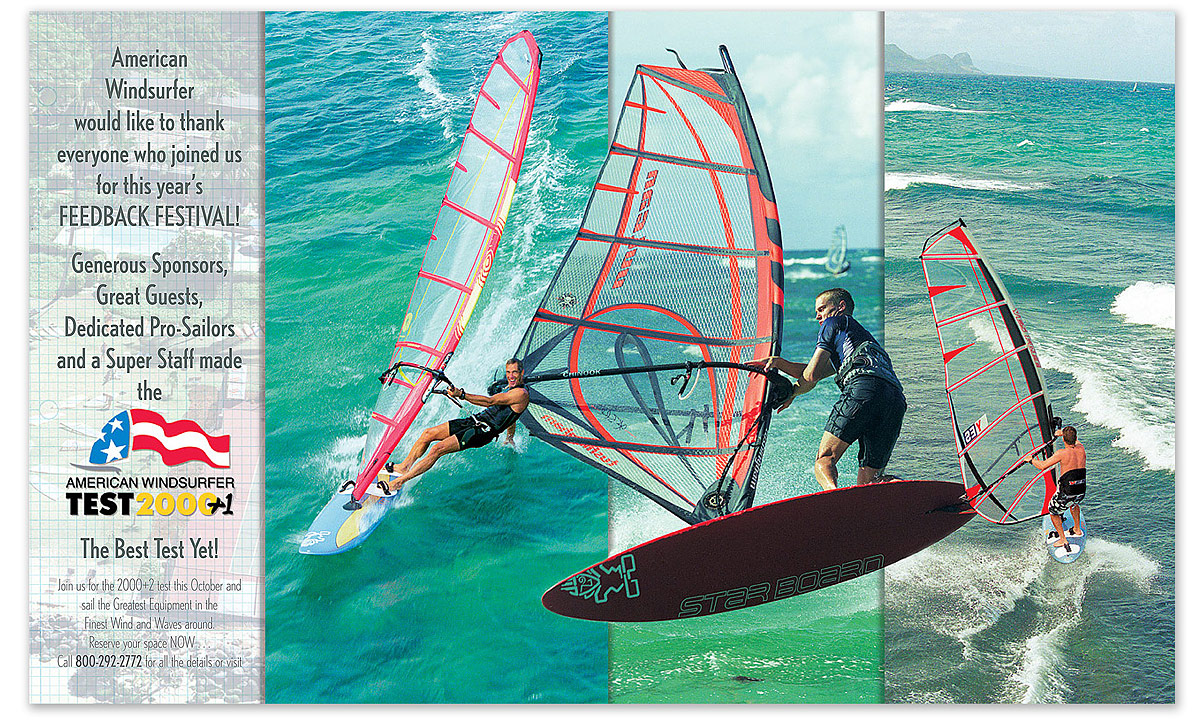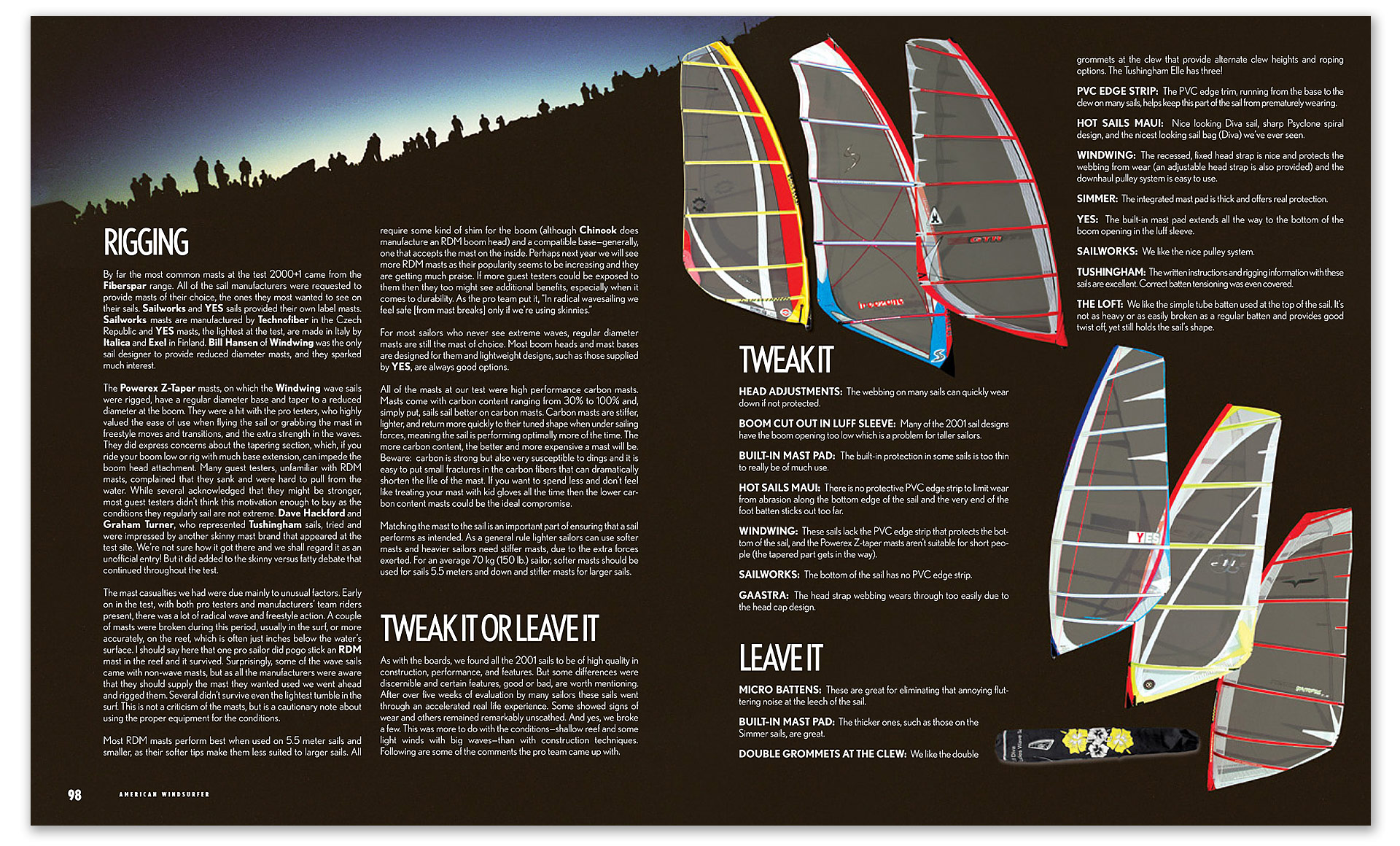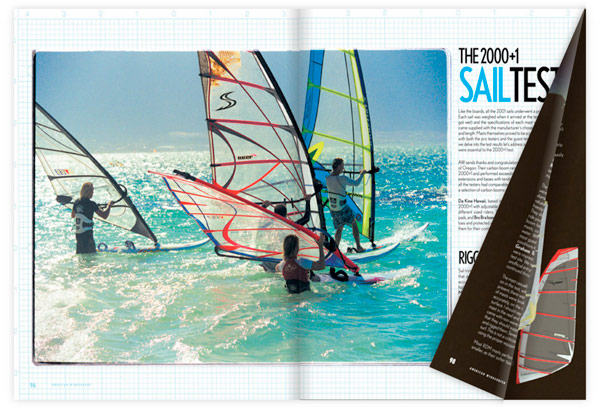
LIKE THE BOARDS, all the 2001 sails underwent a pre-test evaluation. Each sail was weighed when it arrived at the test center (before it got wet) and the specifications of each mast were noted. All sails came supplied with the manufacturer’s chosen mast: make, model, and length. Masts themselves proved to be a great topic for discussion with both the pro testers and the guest testers (see Masts). Before we delve into the test results let’s address some other accessories that were essential to the 2000+1 test.
AW sends thanks and congratulations to Chinook Sailing Products of Oregon. Their carbon boom range is the official boom of the test 2000+1 and performed exceedingly well. They also provided base extensions and bases with tendon universals helping to ensure that all the testers had comparable equipment. Fiberspar, too, provided a selection of carbon booms and receives our thanks.
Da Kine Hawaii, based in Hood River Oregon, supplied the test 2000+1 with adjustable harness lines, essential in a test with many different sized riders. They also provided uphauls, Wai Wai base pads, and Bro Bra boom pads which undoubtedly saved many a riders’ toes and protected all of the boards. American Windsurfer thanks them for their contribution.
Advertisement
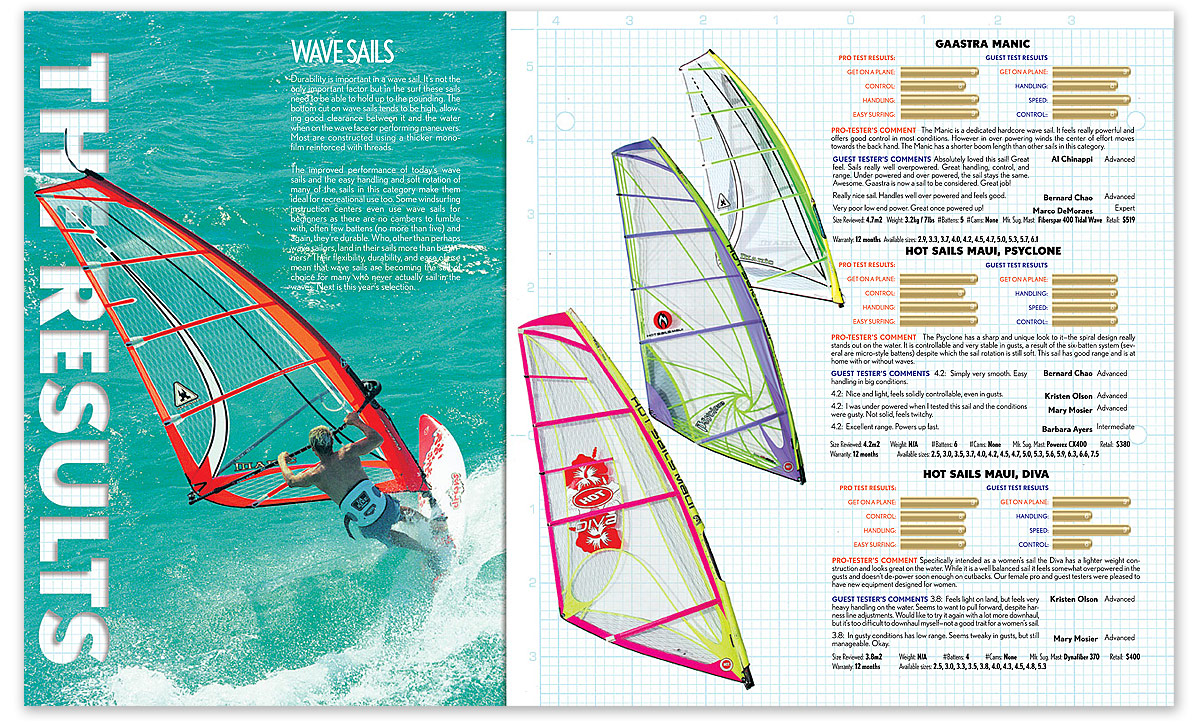
WAVE SAILS
Durability is important in a wave sail. It’s not the only important factor but in the surf these sails need to be able to hold up to the pounding. The bottom cut on wave sails tends to be high, allowing good clearance between it and the water when on the wave face or performing maneuvers. Most are constructed using a thicker monofilm reinforced with threads.The improved performance of today’s wave sails and the easy handling and soft rotation of many of the sails in this category make them ideal for recreational use too. Some windsurfing instruction centers even use wave sails for beginners as there are no cambers to fumble with, often few battens (no more than five) and again, they’re durable. Who, other than perhaps wave sailors, land in their sails more than beginners? Their flexibility, durability, and ease of use mean that wave sails are becoming the sail of choice for many who never actually sail in the waves. Next is this year’s selection.
Rigging
Sail trimming was, as ever, an intricate issue. While we’d all like sails that are uncomplicated and rig easily, the truth is that sails need accurate trimming in order to work as intended. Sail design can be highly technical and sails such as the high performance Gaastra Manic and Simmer sails performed well only when rigged correctly. Others were less susceptible to differences in outhaul and downhaul. Regardless, the way the sail is rigged affects the sailing experience and we attempted to keep the sails trimmed well at all times.
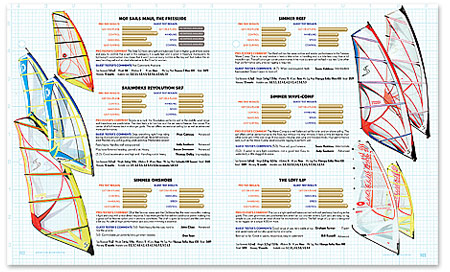
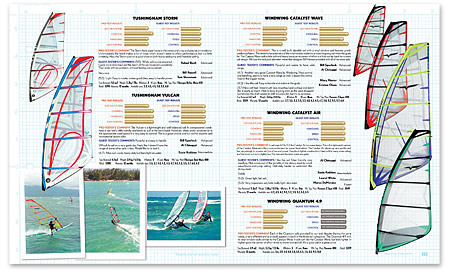

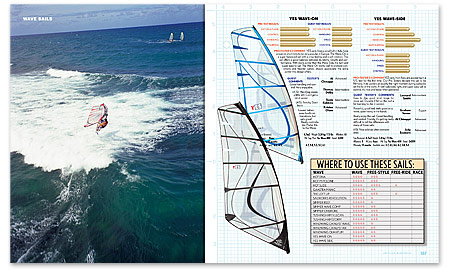
Many sail manufacturers contributed numerous sails, sometimes several from just one sail line. In order to be fair to each manufacturer and to ensure consistent results we tested just one sail from each line—each of our five pro testers had to evaluate the same sail. Notable exceptions to this is the Windwing Quantum—the three sails provided in this line are so clearly different in design that they belong in different categories—and the Windwing Catalyst Air—sails 5.2 and smaller are wave sails, and the larger sails are more freestyle/freeride in design.
By far the most common masts at the test 2000+1 came from the Fiberspar range. All of the sail manufacturers were requested to provide masts of their choice, the ones they most wanted to see on their sails. Sailworks and YES sails provided their own label masts. Sailworks masts are manufactured by Technofiber in the Czech Republic and YES masts, the lightest at the test, are made in Italy by Italica and Exel in Finland. Bill Hansen of Windwing was the only sail designer to provide reduced diameter masts, and they sparked much interest.
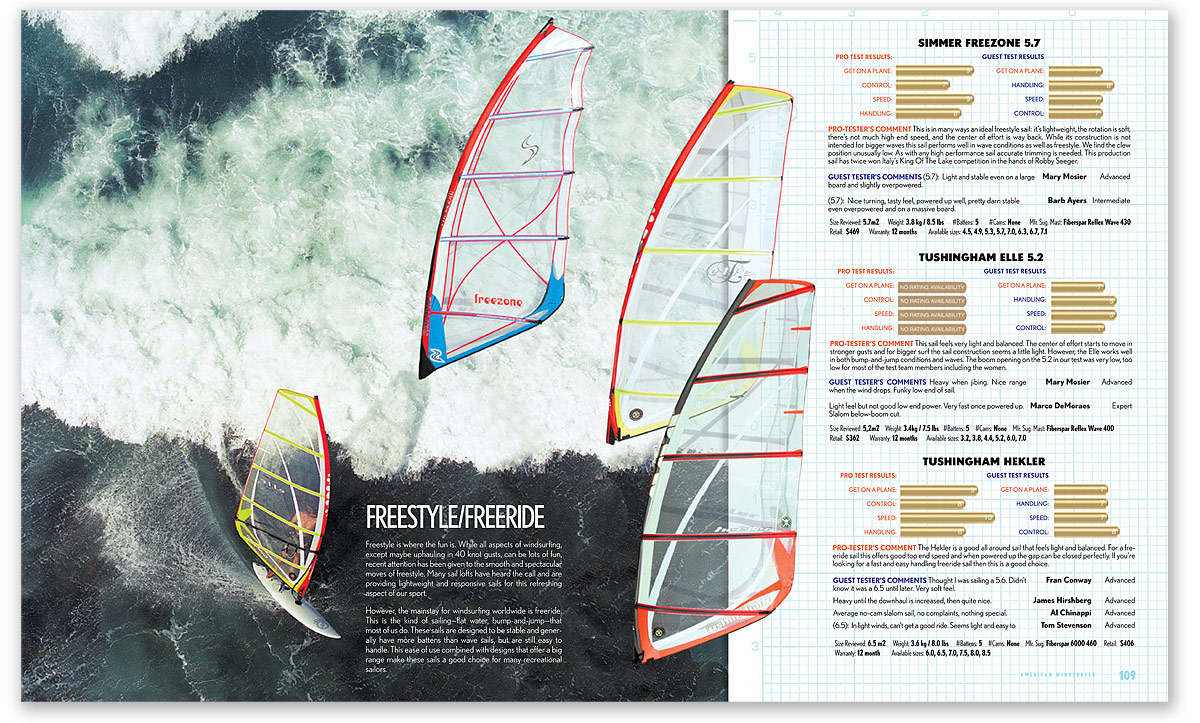
FREESTYLE/FREERIDE
Freestyle is where the fun is. While all aspects of windsurfing, except maybe uphauling in 40 knot gusts, can be lots of fun, recent attention has been given to the smooth and spectacular moves of freestyle. Many sail lofts have heard the call and are providing lightweight and responsive sails for this refreshing aspect of our sport.However, the mainstay for windsurfing worldwide is freeride. This is the kind of sailing—flat water, bump-and-jump—that most of us do. These sails are designed to be stable and generally have more battens than wave sails, but are still easy to handle. This ease of use combined with designs that offer a big range make these sails a good choice for many recreational sailors.
The Powerex Z-Taper masts, on which the Windwing wave sails were rigged, have a regular diameter base and taper to a reduced diameter at the boom. They were a hit with the pro testers, who highly valued the ease of use when flying the sail or grabbing the mast in freestyle moves and transitions, and the extra strength in the waves. They did express concerns about the tapering section, which, if you ride your boom low or rig with much base extension, can impede the boom head attachment. Many guest testers, unfamiliar with RDM masts, complained that they sank and were hard to pull from the water. While several acknowledged that they might be stronger, most guest testers didn’t think this motivation enough to buy as the conditions they regularly sail are not extreme. Dave Hackford and Graham Turner, who represented Tushingham sails, tried and were impressed by another skinny mast brand that appeared at the test site. We’re not sure how it got there and we shall regard it as an unofficial entry! But it did added to the skinny versus fatty debate that continued throughout the test.
The mast casualties we had were due mainly to unusual factors. Early on in the test, with both pro testers and manufacturers’ team riders present, there was a lot of radical wave and freestyle action. A couple of masts were broken during this period, usually in the surf, or more accurately, on the reef, which is often just inches below the water’s surface. I should say here that one pro sailor did pogo stick an RDM mast in the reef and it survived. Surprisingly, some of the wave sails came with non-wave masts, but as all the manufacturers were aware that they should supply the mast they wanted used we went ahead and rigged them. Several didn’t survive even the lightest tumble in the surf. This is not a criticism of the masts, but is a cautionary note about using the proper equipment for the conditions.
Most RDM masts perform best when used on 5.5 meter sails and smaller, as their softer tips make them less suited to larger sails. All require some kind of shim for the boom (although Chinook does manufacture an RDM boom head) and a compatible base—generally, one that accepts the mast on the inside. Perhaps next year we will see more RDM masts as their popularity seems to be increasing and they are getting much praise. If more guest testers could be exposed to them then they too might see additional benefits, especially when it comes to durability. As the pro team put it, “In radical wavesailing we feel safe [from mast breaks] only if we’re using skinnies.”
For most sailors who never see extreme waves, regular diameter masts are still the mast of choice. Most boom heads and mast bases are designed for them and lightweight designs, such as those supplied by YES, are always good options.
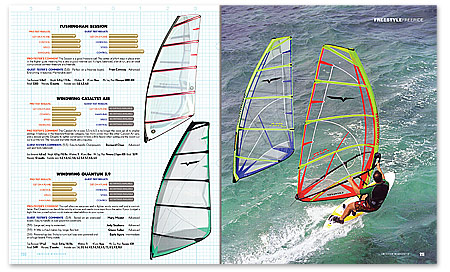
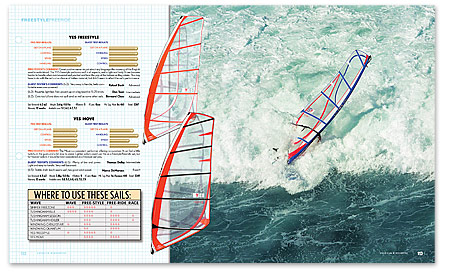
All of the masts at our test were high performance carbon masts. Masts come with carbon content ranging from 30% to 100% and, simply put, sails sail better on carbon masts. Carbon masts are stiffer, lighter, and return more quickly to their tuned shape when under sailing forces, meaning the sail is performing optimally more of the time. The more carbon content, the better and more expensive a mast will be. Beware: carbon is strong but also very susceptible to dings and it is easy to put small fractures in the carbon fibers that can dramatically shorten the life of the mast. If you want to spend less and don’t feel like treating your mast with kid gloves all the time then the lower carbon content masts could be the ideal compromise.
Matching the mast to the sail is an important part of ensuring that a sail performs as intended. As a general rule lighter sailors can use softer masts and heavier sailors need stiffer masts, due to the extra forces exerted. For an average 70 kg (150 lb.) sailor, softer masts should be used for sails 5.5 meters and down and stiffer masts for larger sails.
Advertisement
TWEAK IT OR LEAVE IT
As with the boards, we found all the 2001 sails to be of high quality in construction, performance, and features. But some differences were discernible and certain features, good or bad, are worth mentioning. After over five weeks of evaluation by many sailors these sails went through an accelerated real life experience. Some showed signs of wear and others remained remarkably unscathed. And yes, we broke a few. This was more to do with the conditions—shallow reef and some light winds with big waves—than with construction techniques. Following are some of the comments the pro team came up with.
TWEAK IT
Head Adjustments: The webbing on many sails can quickly wear down if not protected.
Boom Cut Out In Luff Sleeve: Many of the 2001 sail designs have the boom opening too low which is a problem for taller sailors.
Built-In Mast Pad: The built-in protection in some sails is too thin to really be of much use.
HOT SAILS MAUI: There is no protective PVC edge strip to limit wear from abrasion along the bottom edge of the sail and the very end of the foot batten sticks out too far.
WINDWING: These sails lack the PVC edge strip that protects the bottom of the sail, and the Powerex Z-taper masts aren’t suitable for short people (the tapered part gets in the way).
SAILWORKS: The bottom of the sail has no PVC edge strip.
GAASTRA: The head strap webbing wears through too easily due to the head cap design.
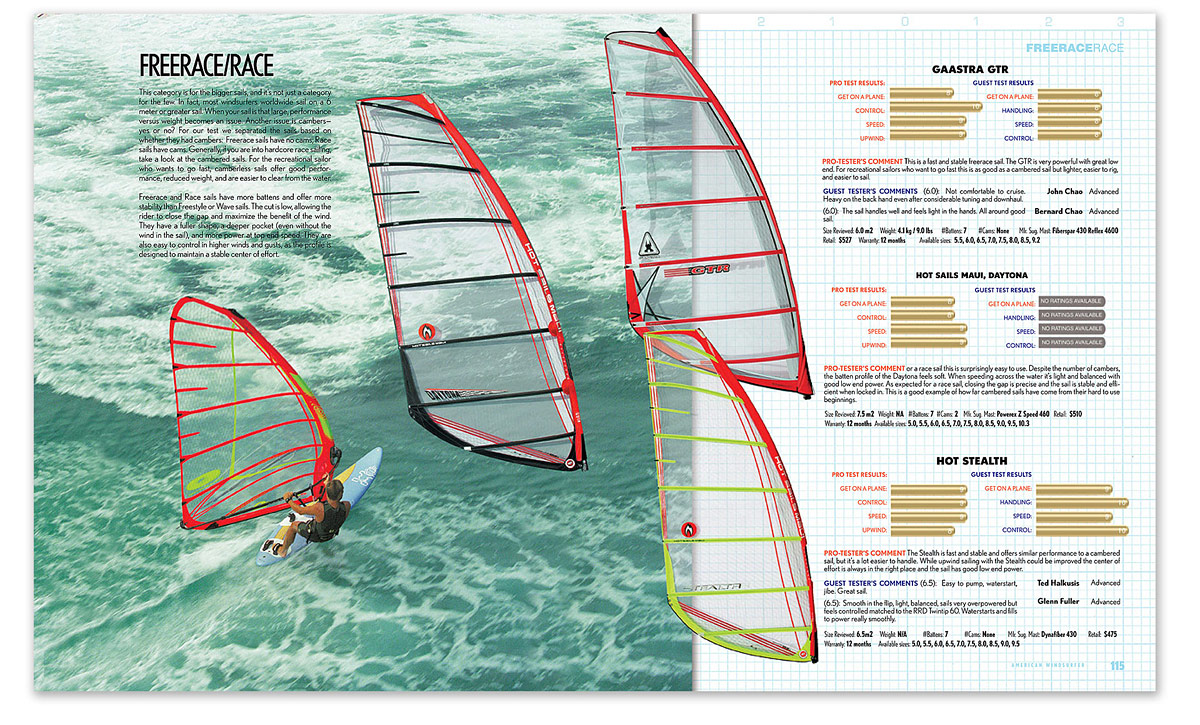
FREERACE/RACE
This category is for the bigger sails, and it’s not just a category for the few. In fact, most windsurfers worldwide sail on a 6 meter or greater sail. When your sail is that large, performance versus weight becomes an issue. Another issue is cambers—yes or no? For our test we separated the sails based on whether they had cambers: Freerace sails have no cams; Race sails have cams. Generally, if you are into hardcore race sailing, take a look at the cambered sails. For the recreational sailor who wants to go fast, camberless sails offer good performance, reduced weight, and are easier to clear from the water.
Freerace and Race sails have more battens and offer more stability than Freestyle or Wave sails. The cut is low, allowing the rider to close the gap and maximize the benefit of the wind. They have a fuller shape, a deeper pocket (even without the wind in the sail), and more power at top end speed. They are also easy to control in higher winds and gusts, as the profile is designed to maintain a stable center of effort.
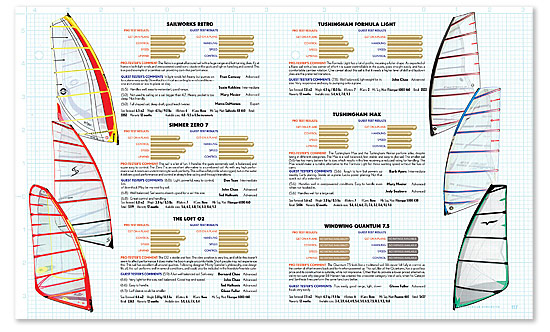
LEAVE IT
Micro Battens: These are great for eliminating that annoying fluttering noise at the leech of the sail.
Built-In Mast Pad: The thicker ones, such as those on the Simmer sails, are great.
Double Grommets at the Clew: We like the double grommets at the clew that provide alternate clew heights and roping options. The Tushingham Elle has three! PVC Edge Strip: The PVC edge trim, running from the base to the clew on many sails, helps keep this part of the sail from prematurely “>wearing.
HOT SAILS MAUI: Nice looking Diva sail, sharp Psyclone spiral design, and the nicest looking sail bag (Diva) we’ve ever seen.
WINDWING: The recessed, fixed head strap is nice and protects the webbing from wear (an adjustable head strap is also provided) and the downhaul pulley system is easy to use.
SIMMER: The integrated mast pad is thick and offers real protection.
YES: The built-in mast pad extends all the way to the bottom of the boom opening in the luff sleeve.
SAILWORKS: We like the nice pulley system.
TUSHINGHAM: The written instructions and rigging information with these sails are excellent. Correct batten tensioning was even covered.
THE LOFT: We like the simple tube batten used at the top of the sail. It’s not as heavy or as easily broken as a regular batten and provides good twist off, yet still holds the sail’s shape.
